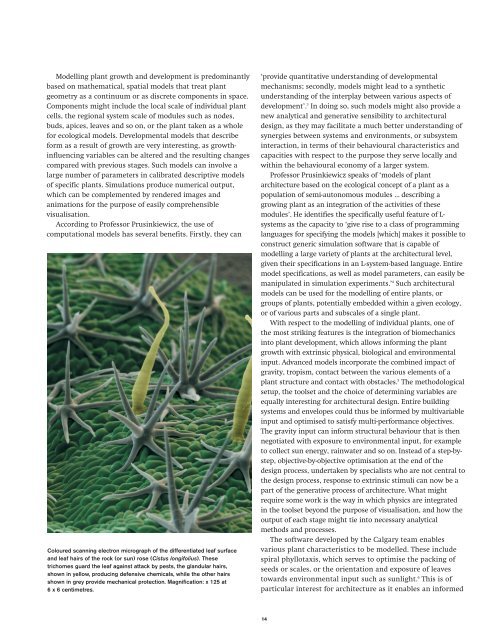Techniques and Technologies in Morphogenetic Design by Michael
Techniques and Technologies in Morphogenetic Design by Michael
Techniques and Technologies in Morphogenetic Design by Michael
Create successful ePaper yourself
Turn your PDF publications into a flip-book with our unique Google optimized e-Paper software.
Modell<strong>in</strong>g plant growth <strong>and</strong> development is predom<strong>in</strong>antly<br />
based on mathematical, spatial models that treat plant<br />
geometry as a cont<strong>in</strong>uum or as discrete components <strong>in</strong> space.<br />
Components might <strong>in</strong>clude the local scale of <strong>in</strong>dividual plant<br />
cells, the regional system scale of modules such as nodes,<br />
buds, apices, leaves <strong>and</strong> so on, or the plant taken as a whole<br />
for ecological models. Developmental models that describe<br />
form as a result of growth are very <strong>in</strong>terest<strong>in</strong>g, as growth<strong>in</strong>fluenc<strong>in</strong>g<br />
variables can be altered <strong>and</strong> the result<strong>in</strong>g changes<br />
compared with previous stages. Such models can <strong>in</strong>volve a<br />
large number of parameters <strong>in</strong> calibrated descriptive models<br />
of specific plants. Simulations produce numerical output,<br />
which can be complemented <strong>by</strong> rendered images <strong>and</strong><br />
animations for the purpose of easily comprehensible<br />
visualisation.<br />
Accord<strong>in</strong>g to Professor Prus<strong>in</strong>kiewicz, the use of<br />
computational models has several benefits. Firstly, they can<br />
Coloured scann<strong>in</strong>g electron micrograph of the differentiated leaf surface<br />
<strong>and</strong> leaf hairs of the rock (or sun) rose (Cistus longifolius). These<br />
trichomes guard the leaf aga<strong>in</strong>st attack <strong>by</strong> pests, the gl<strong>and</strong>ular hairs,<br />
shown <strong>in</strong> yellow, produc<strong>in</strong>g defensive chemicals, while the other hairs<br />
shown <strong>in</strong> grey provide mechanical protection. Magnification: x 125 at<br />
6 x 6 centimetres.<br />
‘provide quantitative underst<strong>and</strong><strong>in</strong>g of developmental<br />
mechanisms; secondly, models might lead to a synthetic<br />
underst<strong>and</strong><strong>in</strong>g of the <strong>in</strong>terplay between various aspects of<br />
development’. 3 In do<strong>in</strong>g so, such models might also provide a<br />
new analytical <strong>and</strong> generative sensibility to architectural<br />
design, as they may facilitate a much better underst<strong>and</strong><strong>in</strong>g of<br />
synergies between systems <strong>and</strong> environments, or subsystem<br />
<strong>in</strong>teraction, <strong>in</strong> terms of their behavioural characteristics <strong>and</strong><br />
capacities with respect to the purpose they serve locally <strong>and</strong><br />
with<strong>in</strong> the behavioural economy of a larger system.<br />
Professor Prus<strong>in</strong>kiewicz speaks of ‘models of plant<br />
architecture based on the ecological concept of a plant as a<br />
population of semi-autonomous modules … describ<strong>in</strong>g a<br />
grow<strong>in</strong>g plant as an <strong>in</strong>tegration of the activities of these<br />
modules’. He identifies the specifically useful feature of Lsystems<br />
as the capacity to ‘give rise to a class of programm<strong>in</strong>g<br />
languages for specify<strong>in</strong>g the models [which] makes it possible to<br />
construct generic simulation software that is capable of<br />
modell<strong>in</strong>g a large variety of plants at the architectural level,<br />
given their specifications <strong>in</strong> an L-system-based language. Entire<br />
model specifications, as well as model parameters, can easily be<br />
manipulated <strong>in</strong> simulation experiments.’ 4 Such architectural<br />
models can be used for the modell<strong>in</strong>g of entire plants, or<br />
groups of plants, potentially embedded with<strong>in</strong> a given ecology,<br />
or of various parts <strong>and</strong> subscales of a s<strong>in</strong>gle plant.<br />
With respect to the modell<strong>in</strong>g of <strong>in</strong>dividual plants, one of<br />
the most strik<strong>in</strong>g features is the <strong>in</strong>tegration of biomechanics<br />
<strong>in</strong>to plant development, which allows <strong>in</strong>form<strong>in</strong>g the plant<br />
growth with extr<strong>in</strong>sic physical, biological <strong>and</strong> environmental<br />
<strong>in</strong>put. Advanced models <strong>in</strong>corporate the comb<strong>in</strong>ed impact of<br />
gravity, tropism, contact between the various elements of a<br />
plant structure <strong>and</strong> contact with obstacles. 5 The methodological<br />
setup, the toolset <strong>and</strong> the choice of determ<strong>in</strong><strong>in</strong>g variables are<br />
equally <strong>in</strong>terest<strong>in</strong>g for architectural design. Entire build<strong>in</strong>g<br />
systems <strong>and</strong> envelopes could thus be <strong>in</strong>formed <strong>by</strong> multivariable<br />
<strong>in</strong>put <strong>and</strong> optimised to satisfy multi-performance objectives.<br />
The gravity <strong>in</strong>put can <strong>in</strong>form structural behaviour that is then<br />
negotiated with exposure to environmental <strong>in</strong>put, for example<br />
to collect sun energy, ra<strong>in</strong>water <strong>and</strong> so on. Instead of a step-<strong>by</strong>step,<br />
objective-<strong>by</strong>-objective optimisation at the end of the<br />
design process, undertaken <strong>by</strong> specialists who are not central to<br />
the design process, response to extr<strong>in</strong>sic stimuli can now be a<br />
part of the generative process of architecture. What might<br />
require some work is the way <strong>in</strong> which physics are <strong>in</strong>tegrated<br />
<strong>in</strong> the toolset beyond the purpose of visualisation, <strong>and</strong> how the<br />
output of each stage might tie <strong>in</strong>to necessary analytical<br />
methods <strong>and</strong> processes.<br />
The software developed <strong>by</strong> the Calgary team enables<br />
various plant characteristics to be modelled. These <strong>in</strong>clude<br />
spiral phyllotaxis, which serves to optimise the pack<strong>in</strong>g of<br />
seeds or scales, or the orientation <strong>and</strong> exposure of leaves<br />
towards environmental <strong>in</strong>put such as sunlight. 6 This is of<br />
particular <strong>in</strong>terest for architecture as it enables an <strong>in</strong>formed<br />
14


